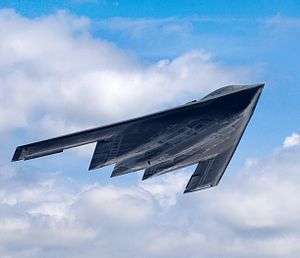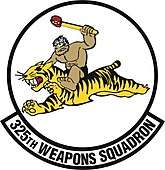325th Weapons Squadron
The 325th Weapons Squadron is a United States Air Force unit assigned to the USAF Weapons School, stationed at Whiteman Air Force Base, Missouri.
325th Weapons Squadron
 | |
|---|---|
 B-2 Spirit assigned to Whiteman AFB, Missouri | |
| Active | 1942–1994; 1946–1994; 1998—present |
| Country | |
| Branch | |
| Type | Squadron |
| Role | Advanced B-2 Spirit Training |
| Part of | Air Combat Command |
| Garrison/HQ | Whiteman Air Force Base, Missouri |
| Engagements | World War II
Korean War[1] |
| Decorations | Distinguished Unit Citation (2x) Air Force Outstanding Unit Award with Combat "V" Device Air Force Outstanding Unit Award (13x) Republic of Korea Presidential Unit Citation Republic of Vietnam Gallantry Cross with Palm |
| Battle honours | [1] |
| Insignia | |
| 325th Weapons Squadron emblem (approved 3 June 1943)[1] |  |
The 325th is a geographically separated unit of the 57th Wing at Nellis Air Force Base, Nevada. The mission of the squadron is to provide Northrop Grumman B-2 Spirit instructional flying.
History
World War II
Activated as a Boeing B-17 Flying Fortress heavy bomb squadron in early 1942; trained by Third Air Force in the southeastern United States. Deployed to European Theater of Operations, being assigned to VIII Bomber Command in England, one of the first squadrons being assigned to the command.
In England, the squadron initially trained replacement crews for combat at RAF Bovingdon. During the period from 18 August 1942 through 6 January 43, the squadron flew four combat missions while conducting replacement crew training. Upon completion of its training mission, the 325th moved to RAF Alconbury on 6 January 1943 where it and its parent 92d Bombardment Group underwent reorganization. When they emerged in May 1943, the 92 BG and 325 BS were ready for combat. The group's B-17s, flew their first post-reorganization combat mission on 15 May 1943.
On 20 August 1943, the personnel and aircraft were assumed by the 813th Bombardment Squadron (Pathfinder).
In September 1943, the squadron was re-equipped with replacement personnel and aircraft, and was once again moved, this time to RAF Podington, where it would remain until the until German capitulation in May 1945. The 92d Bombardment Group flew its last combat mission on 25 April 1945 when it had the distinction of leading the Eighth Air Force's final sortie of the conflict. The group flew a total of 308 combat missions.
Reassigned to Air Transport Command in June 1945 as part of Operation Green. Used B-17s as transports, flying demobilized personnel to ATC sites in Morocco and Azores from France. Aircraft turrets were removed and re-skinned, the bomb racks removed, flooring and seating installed to accommodate 30 passengers. The flight crew was reduced to pilot, co-pilot, navigator, flight engineer and radio operator. In addition the engineer and radio operator would act as stewards, to assist and calm the many first time flyers. The 325th's aircraft helped move 19,935 troops while also helping to return 5,672 Frenchmen to France. Inactivated in February 1946.
Strategic Air Command
Reactivated as a Strategic Air Command Boeing B-29 Superfortress squadron in July 1946. Performed strategic bombardment training until 1950; being deployed to Far East Air Forces and flying combat missions over North Korea. Under control of the FEAF Bomber Command (Provisional) until 20 October, the squadron bombed factories, refineries, iron works, hydroelectric plants, airfields, bridges, tunnels, troop concentrations, barracks, marshalling yards, road junctions, rail lines, supply dumps, docks, vehicles and other strategic and interdiction targets. Returned to Spokane Air Force Base, Washington in late October and November 1950.
Re-equipped with Convair B-36 Peacemaker intercontinental strategic bomber in 1951. Engaged in training operations on a worldwide scale; being upgraded to Boeing B-52 Stratofortress in 1957 standing nuclear alert until being stood down in 1992 at the end of the Cold War.
Weapons squadron
Reactivated as a Northrop Grumman B-2 Spirit bomb squadron in 1998. Taken off operational flying status, being redesignated as a weapons training squadron at Whiteman in 2005, assuming assets on inactivated 715th Weapons Squadron.
Lineage
- Constituted as the 325 Bombardment Squadron (Heavy) on 28 January 1942
- Activated on 1 March 1942
- Redesignated 325 Bombardment Squadron, Heavy on 29 September 1944
- Inactivated on 28 February 1946
- Redesignated 325 Bombardment Squadron, Very Heavy on 15 July 1946
- Activated on 4 August 1946
- Redesignated 325 Bombardment Squadron, Medium on 28 May 1948
- Redesignated 325 Bombardment Squadron, Heavy on 16 June 1951
- Redesignated 325 Bomb Squadron on 1 September 1991
- Inactivated on 1 July 1994
- Activated on 6 January 1998
- Redesignated 325th Weapons Squadron 9 September 2005
- Activated on 9 September 2005[1]
Assignments
- 92d Bombardment Group, 1 March 1942 – 28 February 1946 (non-Operational 20 August–15 September 1943)
- 92d Bombardment Group, 4 August 1946 (attached to 92d Bombardment Wing after 16 February 1951)
- 92d Bombardment Wing (later 92d Strategic Aerospace Wing, 92d Bombardment Wing), 16 June 1952
- 92d Operations Group, 1 September 1991 – 1 July 1994
- 509th Operations Group, 6 January 1998
- USAF Weapons School, 9 September 2005 – present[1]
Stations
- Barksdale Field, Louisiana, 1 March 1942
- MacDill Field, Florida, 26 March 1942
- Sarasota Army Air Field, Florida, 18 May–July 1942
- RAF Bovingdon (AAF-112),[2] England, August 1942
- RAF Alconbury (AAF-102),[2] England, January 1943
- RAF Podington (AAF-109),[2] England, 15 September 1943
- Istres-le Tubé Airfield (Y-17),[3] France, June 1945 – 28 February 1946
- Fort Worth Army Air Field, Texas, 4 August 1946
- Smoky Hill Army Air Field, Kansas, 26 October 1946
- Spokane Army Air Field (later Spokane Air Force Base, Fairchild Air Force Base), Washington, 20 June 1947 – 1 July 1994 (deployed to Yokota Air Base, Japan, 9 July29 October 1950, Andersen Air Force Base, Guam, 16 October 1954-12 January 1955 and 26 April–5 July 1956)
- Whiteman Air Force Base, Missouri, 6 January 1998 – present[4]
Aircraft
- Boeing B-17 Flying Fortress, 1942–1946
- Boeing B-29 Superfortress, 1946, 1947–1951
- Convair B-36 Peacemaker, 1951–1957
- Boeing B-52 Stratofortress, 1957–1994
- Northrop Grumman B-2 Spirit, 1998–2005[1]
References
- Notes
- Bailey, Carl E. (15 April 2008). "Factsheet 325 Weapons Squadron (ACC)". Air Force Historical Research Agency. Retrieved 10 August 2017.
- Station number in Anderson.
- Station number in Johnson.
- Station information in Beiley, except as noted.
Bibliography
![]()
- Anderson, Capt. Barry (1985). Army Air Forces Stations: A Guide to the Stations Where U.S. Army Air Forces Personnel Served in the United Kingdom During World War II (PDF). Maxwell AFB, AL yes: Research Division, USAF Historical Research Center. Archived from the original (PDF) on 23 January 2016. Retrieved 28 June 2017.
- Johnson, 1st Lt. David C. (1988). U.S. Army Air Forces Continental Airfields (ETO) D-Day to V-E Day (PDF). Maxwell AFB, AL: Research Division, USAF Historical Research Center. Archived from the original (PDF) on 29 September 2015. Retrieved 26 June 2017.
- Maurer, Maurer, ed. (1983) [1961]. Air Force Combat Units of World War II (PDF) (reprint ed.). Washington, DC: Office of Air Force History. ISBN 0-912799-02-1. LCCN 61060979. Retrieved 17 December 2016.
- Maurer, Maurer, ed. (1982) [1969]. Combat Squadrons of the Air Force, World War II (PDF) (reprint ed.). Washington, DC: Office of Air Force History. ISBN 0-405-12194-6. LCCN 70605402. OCLC 72556. Retrieved 17 December 2016.
- Ravenstein, Charles A. (1984). Air Force Combat Wings, Lineage & Honors Histories 1947–1977. Washington, DC: Office of Air Force History. ISBN 0-912799-12-9. Retrieved 17 December 2016.

